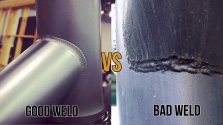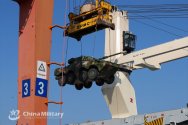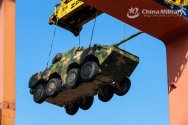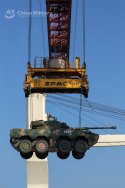Those welds don’t look very good.A welding robot on a tank production line.




You are using an out of date browser. It may not display this or other websites correctly.
You should upgrade or use an alternative browser.
You should upgrade or use an alternative browser.
PLA Ground Forces news, pics and videos
- Thread starter Jeff Head
- Start date
by78
General
Those welds don’t look very good.
Please explain. Are you a welder?
You don't have to be a welder to spot a bad weld. The screenshot is low res so I won't be conclusive but initial thoughts from me is, I agree with Andy1974. They don't appear to be a good weld at all. A pretty obvious bad weld is lumpy and not uniform which appears to be that of robot weld screenshots.Please explain. Are you a welder?

by78
General
You don't have to be a welder to spot a bad weld. The screenshot is low res so I won't be conclusive but initial thoughts from me is, I agree with Andy1974. They don't appear to be a good weld at all. A pretty obvious bad weld is lumpy and not uniform which appears to be that of robot weld screenshots.
View attachment 99704
Are you a welder? How can you tell from blurry screen captures in bad lighting that those are bad welds, when the seams themselves are barely 2mm on the computer screen, not to mention that they have yet to be sanded, smoothed, and painted?
Last edited:
Although I am not a welder, I have been exposed to the operational procedures of fatigue testing for weld evaluation. I think if a more objective assessment of weld quality is required, at least higher resolution pictures are needed. In addition, the factory usually does not approve the process flow until the static load test, fatigue test and sampling inspection of the welded test are qualified. I just have engineering experience with civilian equipment, military equipment obviously needs a higher standard.Are you a welder? How can you tell from blurry screen captures in bad lighting that those are bad welds, when the seams themselves are barely 2mm on the computer screen, not to mention that they have yet to be sanded, smoothed, and painted?
Not a welder either, but AFAIK that only applies to manual welds. The pattern on the left is from the sort of back-out pattern manual welders use to help control their bead size / settings /etc.You don't have to be a welder to spot a bad weld. The screenshot is low res so I won't be conclusive but initial thoughts from me is, I agree with Andy1974. They don't appear to be a good weld at all. A pretty obvious bad weld is lumpy and not uniform which appears to be that of robot weld screenshots.
View attachment 99704
None of that applies to robot welds. All the robot welds I have seen only look like straight lines. They have no other recognizable pattern to them. So the tank production weld above looks about right for a robot-weld.
what you are seeing is just the slag from the sub arc welding.... the robot just did a pass so the workers haven't had a chance to chip away the slag yet.... Its robotic welding, but still needs people to come in and chip/grind the slag away so you can NDE the welds..@Godzilla, do you mind weighing in here? Your opinion would be highly valuable. The debate starts at post #2,062.
The Chinese seems to utilize the robotic welders better than the west. They all have access to the same machines, but like they say, its how you use the tools lol. The failure rate on those robotic welders in some of the Chinese shops are sub 1%, even some Indian shops are getting sub 2%. They have alot higher failure rates in some of the shops in the US so they are left idle lol.
The key is getting the software tuned to the repetitive high volume work lol, like making loads of these turrets, or pipe/structural skids that are the same. Then you can figure out the kinks in the software and get the failure rate right down. If you try to fk around with it as if it is the same as a manual laborer then of course you are gonna have it stuff up alot...




